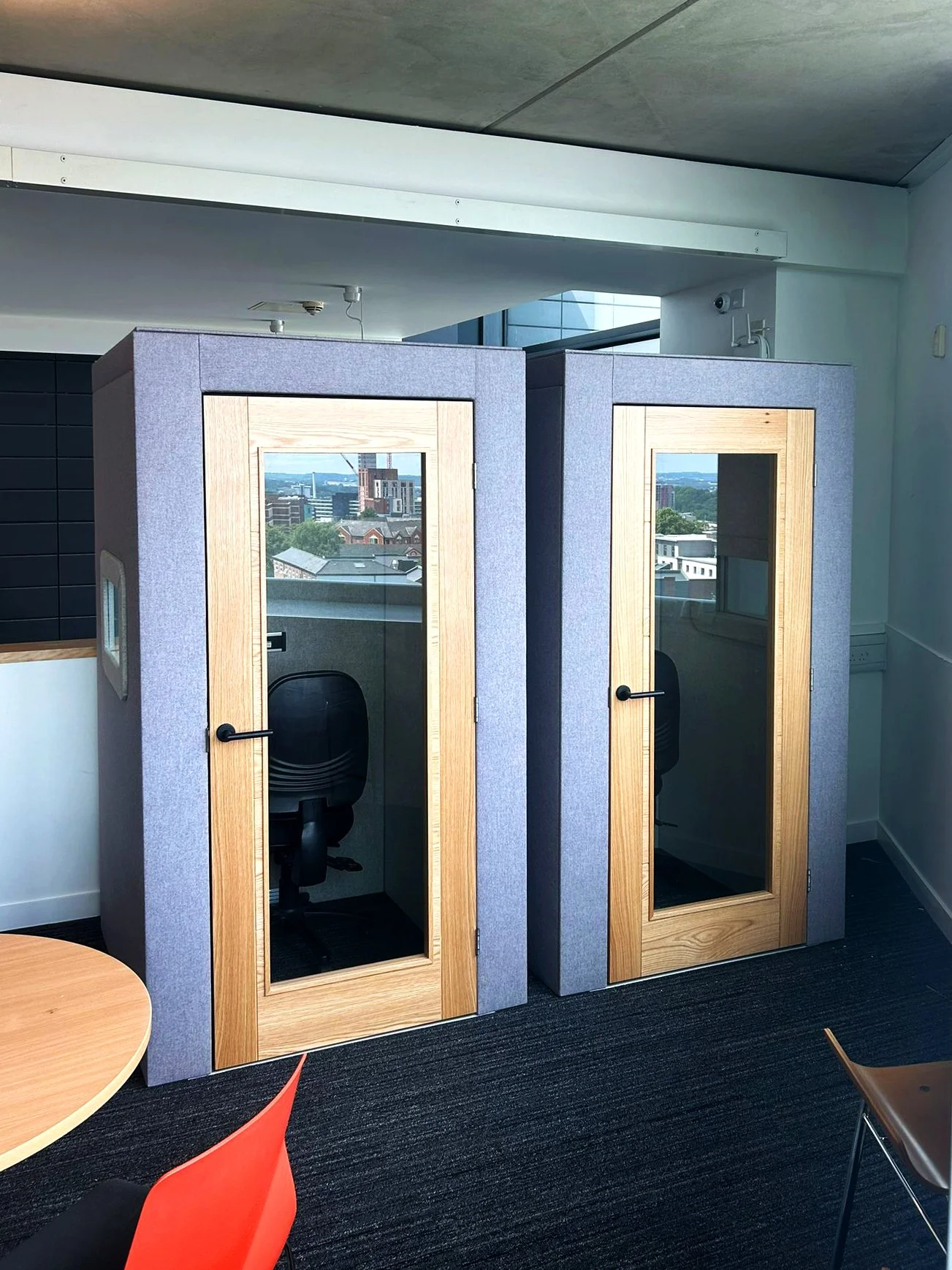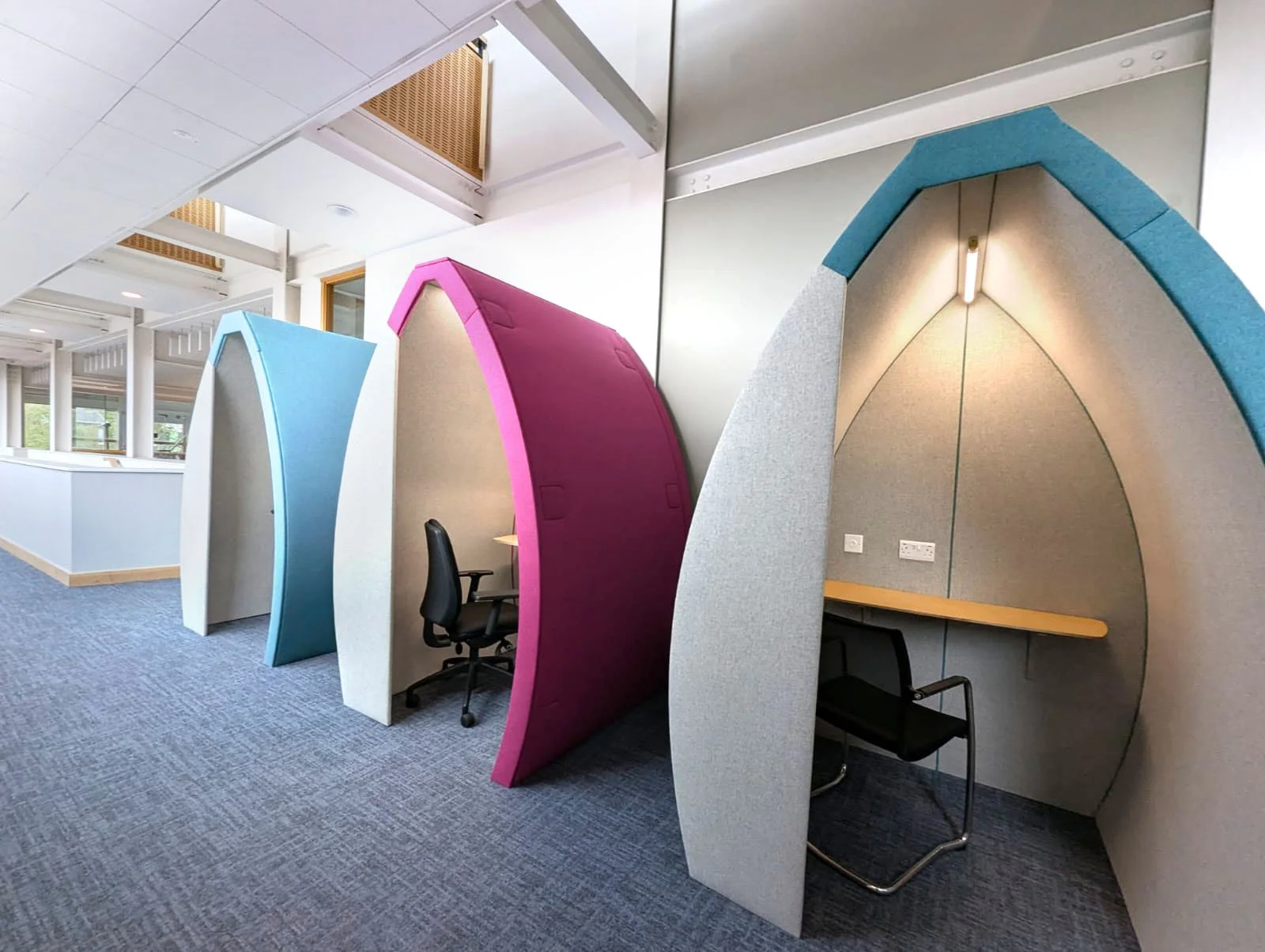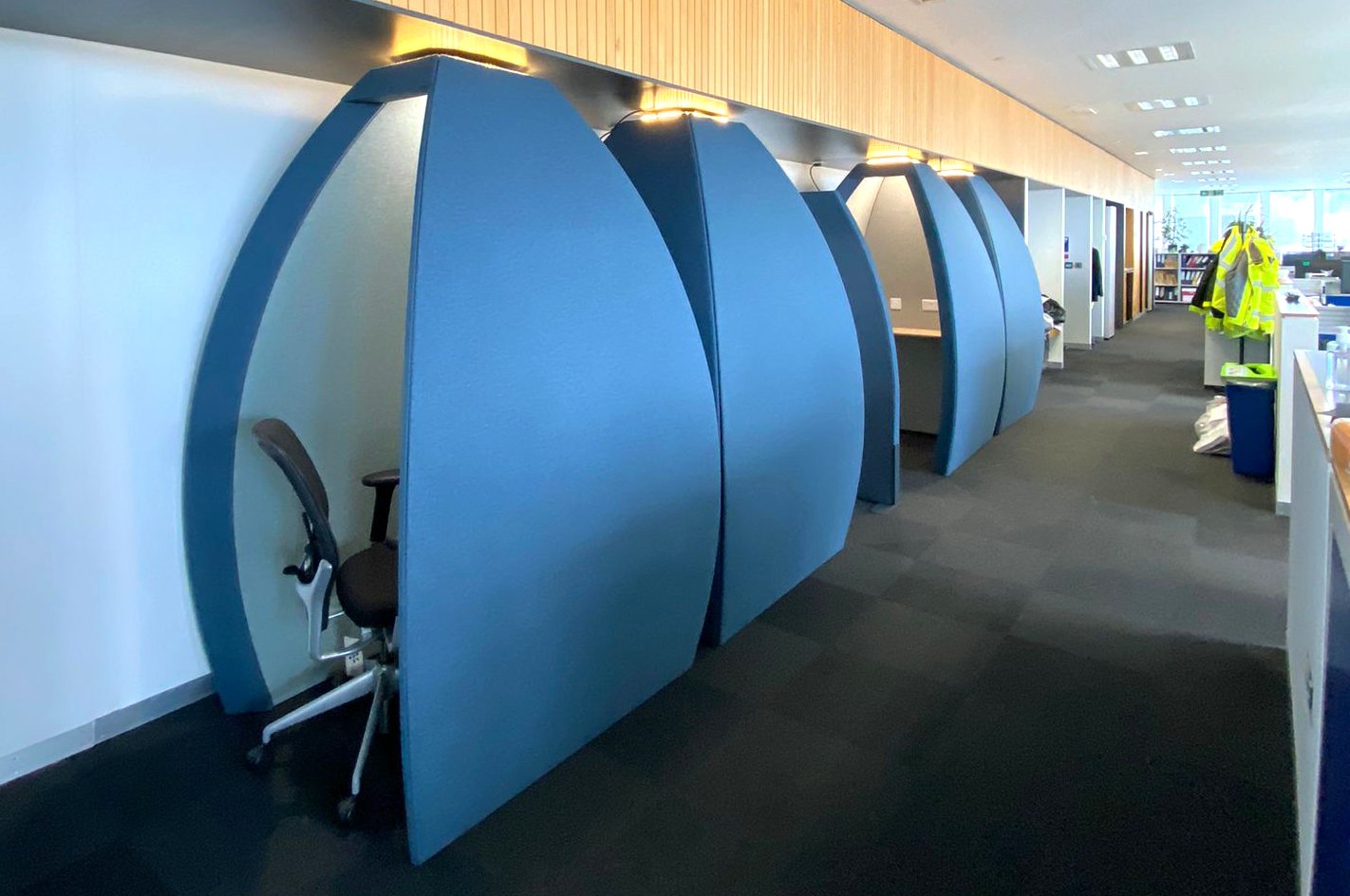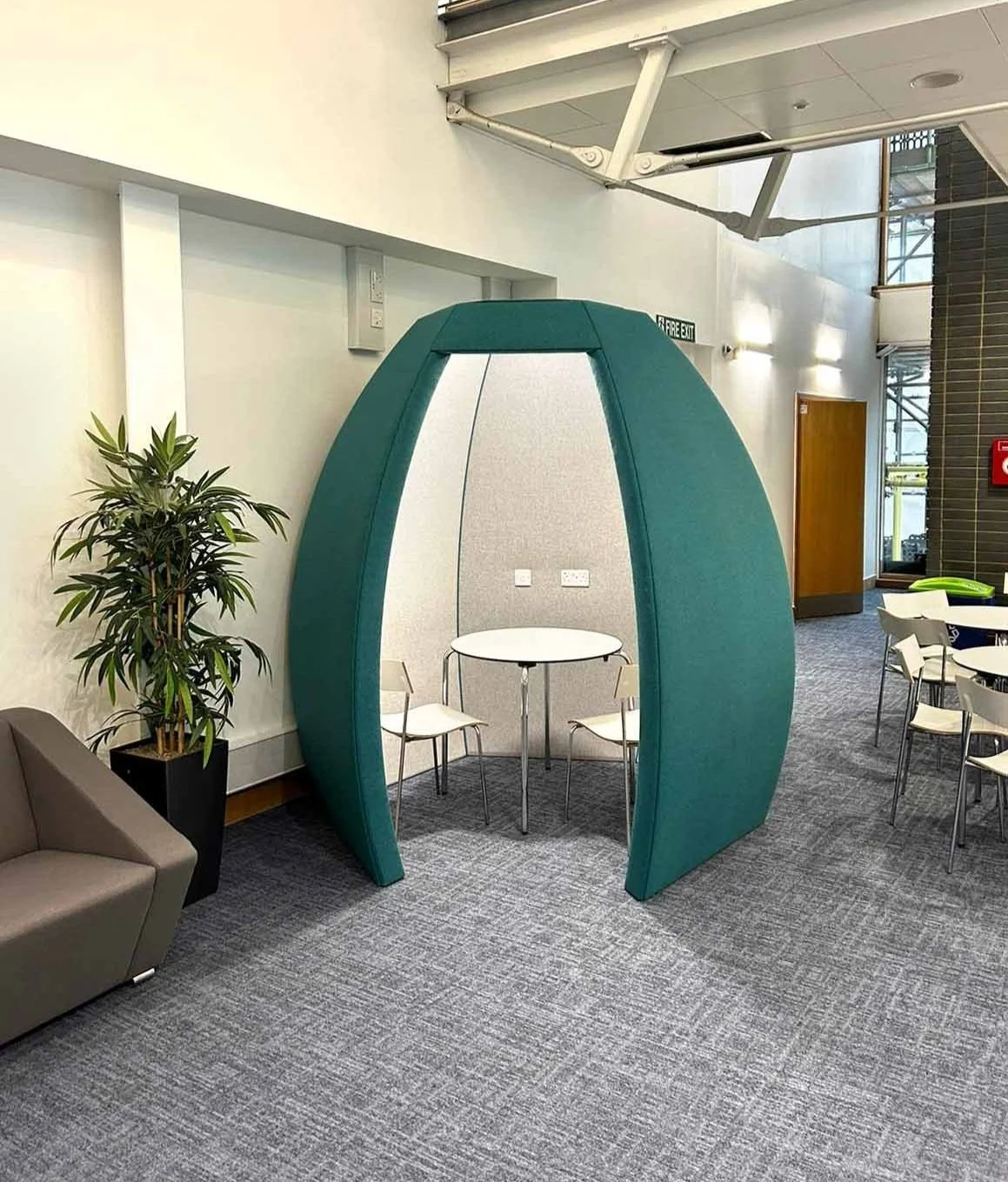The Importance of Good Acoustics in Higher Education: Student Study and Staff Settings
Author: Kay Green, Head of Strategic Space Management, University of Sheffield
Date: 28.07.25
Why Acoustics Matter for Student Learning & Staff Well‑being 🎓
Modern higher education environments—lecture halls, libraries, study zones, staff offices—are designed for flexibility and collaboration. But with that openness comes a downside: sound. Echoes, overlapping conversations, and ambient noise can undermine both teaching and learning.
By investing in high-quality modular acoustic furniture and meeting pods, universities can proactively improve concentration, reduce cognitive fatigue, and make study and teaching spaces more inclusive and effective for everyone.
How Noise Disrupts Learning & Teaching
Reduced Speech Intelligibility
Echoes and background din disrupt students' ability to hear instructors or peers. Studies link heightened reverberation and noise to lowered academic performance.
Strain for Students & Staff
Both staff and students risk vocal fatigue and cognitive overload when trying to be heard or filter out distractions—learning suffers where speech clarity falters.
Worse for Cognitive & Neurodiverse Needs
Learners with ADHD, auditory processing issues, or English language learners are particularly vulnerable; even moderate noise impairs comprehension and retention.
Acoustic Solutions in Student Study Areas
The University of Sheffield has successfully introduced a range of acoustic furniture solutions in recent years, with noticeable positive impact across its campuses.
Meeting Room Solutions
With hybrid meetings becoming the norm, acoustic treatment in meeting rooms is more important than ever to improve sound quality for remote participants—reducing echo and the tinny audio often experienced online.
Study pods & work booths
Private, semi-enclosed booths designed with market-leading acoustic performance give students quiet zones to focus without distractions.
Ideal for both solo and small-group study.
Partitions & acoustic furniture
Moveable and modular screens and high-backed sofas absorb noise and visually delineate work and study zones, reducing ambient chatter in open-plan rooms.
Wall and ceiling treatments
Fabric panels, acoustic clouds, and baffles dampen echo and reverb in large or high-ceilinged spaces.
Flooring materials
Carpets or soft vinyl help curb footfall noise, supporting quieter environments.
Impact on Teaching & Collaboration
Lecture halls equipped with ceiling baffles and wall panels transition from poor auditory environments to highly intelligible spaces.
Active-learning rooms—where students work in groups—benefit from distributed acoustic treatment and amplification systems to ensure voices carry across the space.
Staff offices & meeting rooms with modular acoustic panels and pods enable focused private conversations, reducing interruptions in open-plan areas.
Why Acoustics Should Be a Design Priority
Early planning matters: Even a basic choice of wall, ceiling, or flooring greatly affects reverberation times. Acoustic consultation during design ensures spaces function as intended.
Assessment drives improvement: Measuring reverberation times or background noise reveals areas in need of retrofit.
Ensure accessibility: Acoustic furniture used in higher education settings should be inclusive and accessible to all students and staff, including those with mobility or sensory needs.
Value Beyond Sound
Well-being boost: Calm, controlled acoustics reduce stress and cognitive fatigue for both students and staff.
Inclusivity and compliance: Good sound environments are essential for neurodiverse and hearing-impaired users, supporting equitable access.
Flexibility: Acoustic furniture is often modular and relocatable, adapting to different room layouts and purposes—ideal for evolving academic environments.
Acoustic Solutions at the University of Sheffield
The University of Sheffield has implemented several effective acoustic strategies across its campus, demonstrating how thoughtful design can enhance learning and staff environments:
Information Commons (IC)
The IC combines flexible library and computing zones with 1,300 study spaces; many located in semi-enclosed booths and high-backed sofas. These furnishings, alongside open shelving, create acoustic separation for focused work and small-group discussions.
A major interior refit in 2017 emphasised soft furnishings and partitions to dampen ambient noise, dramatically improving user comfort and speech clarity.
Western Bank Library
This Grade II* listed library underwent a significant restoration in 2010–2012, introducing new group-study rooms and refurbished seating areas. These rooms feature modern acoustic treatments that control reverberation and reduce noise bleed into the main reading areas.
The result: a balance between preserving architectural heritage and delivering high-quality acoustic environments for students and staff.
The Diamond Building
The Diamond opened in late 2015, this landmark building includes a vast central atrium with curved seminar pods (IT suites and small group spaces) visually and acoustically separated from the main hall.
These pods demonstrate effective acoustic zoning: enabling ambient interaction in the atrium while preserving quiet zones for focused study or meetings.
Why This Works
Acoustic zoning through booths, pods, and partitions allows multiple activities—quiet study, group work, socialising—to coexist without conflict.
Soft acoustical finishes and targeted enclosures reduce noise within a larger, open environment, improving concentration and reducing cognitive fatigue.
By combining strategic layout, purpose-built spaces, and research-led application, the University of Sheffield offers a textbook example of how higher education institutions can use acoustics to enhance both student experience and staff efficacy.
Takeaways for Campus Designers & Leaders
Step Recommendation
Audit acoustic conditions: measure noise levels and reverb times where possible.
Plan acoustics early include treatment in walls, ceiling, and floors.
Invest in acoustic furniture: pods, panels, partitions and baffles offer flexible quiet zones.
Focus on inclusivity & accessibility: Choose acoustic solutions that support neurodiverse individuals, hearing-impaired learners, and those with physical accessibility needs to ensure all users can benefit equally from the space.
Monitor & maintain review acoustic performance periodically; replace worn panels or flooring as needed. Gather user feedback and tweak the design where possible.
Final Thoughts
Good acoustics are more than a design afterthought—they’re fundamental to modern higher-education pedagogy and staff satisfaction. By reducing noise, enhancing clarity, and providing flexible quiet and collaborative zones, institutions unlock not just better performance, but a more inclusive campus culture.
BTW, acoustic pods shouldn’t be too soundproof — it’s crucial that users can still hear building fire alarms if they’re triggered. Always test this before committing to a specific solution.









